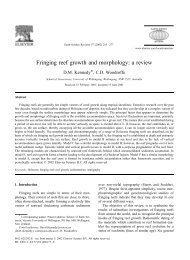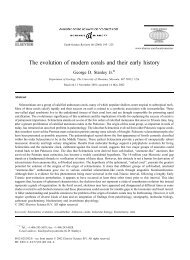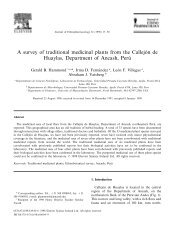Population status of the Orinico crododile in Venezuela
Population status of the Orinico crododile in Venezuela
Population status of the Orinico crododile in Venezuela
You also want an ePaper? Increase the reach of your titles
YUMPU automatically turns print PDFs into web optimized ePapers that Google loves.
356 A.E. Seijas, C. ChaÂvez / Biological Conservation 94 (2000) 353±361<br />
Fig. 2. Annual pattern <strong>of</strong> precipitation and river discharge <strong>in</strong> <strong>the</strong><br />
Cojedes River System, <strong>Venezuela</strong>. Data <strong>of</strong> river discharge are from <strong>the</strong><br />
metereological station at El Bau l. Precipitation data from Palo Quemado<br />
lat. 9 25 0 ; long. 68 42 0 elev. 136).<br />
were conducted <strong>in</strong> every river section. This method<br />
allowed comparison <strong>of</strong> <strong>the</strong> results <strong>of</strong> localities with different<br />
PI. A correlation analysis was used to describe<br />
<strong>the</strong> relationship between <strong>the</strong>se percentages and days<br />
after 1 January, an <strong>in</strong>direct measure <strong>of</strong> water level.<br />
Surveys conducted <strong>in</strong> November and December (early<br />
dry season) were assigned day zero. A similar procedure<br />
was used to determ<strong>in</strong>e whe<strong>the</strong>r <strong>the</strong> probability <strong>of</strong> see<strong>in</strong>g<br />
a crocodile, as <strong>the</strong> dry season progressed, was related to<br />
its size. For <strong>the</strong>se analysis, only <strong>the</strong> river sections with<br />
<strong>the</strong> largest number <strong>of</strong> surveys (CAN, CAS and CAM)<br />
were used. Surveyed segments less than 5 km <strong>in</strong> length<br />
were also excluded.<br />
<strong>Population</strong> <strong>in</strong>dices <strong>of</strong> crocodiles were compared<br />
among river sections by means <strong>of</strong> analysis <strong>of</strong> covariance<br />
(PROC GLM, SAS Institute Inc., 1987) us<strong>in</strong>g days after<br />
1 January as a covariate. This approach removed bias<br />
<strong>in</strong>troduced by di€erences <strong>in</strong> how far <strong>in</strong>to <strong>the</strong> dry season<br />
<strong>the</strong> surveys were conducted. To calculate <strong>the</strong> m<strong>in</strong>imum<br />
population size <strong>of</strong> C. <strong>in</strong>termedius <strong>in</strong> <strong>the</strong> entire study<br />
area, we estimated <strong>the</strong> density <strong>of</strong> crocodiles <strong>in</strong> unsurveyed<br />
reaches <strong>of</strong> <strong>the</strong> river as a value <strong>in</strong>termediate<br />
between <strong>the</strong> PI <strong>of</strong> its immediate upper and lower reaches<br />
for which <strong>in</strong>formation was available.<br />
The population structure <strong>of</strong> crocodiles at localities<br />
with two or more surveys per year was calculated us<strong>in</strong>g<br />
<strong>the</strong> maximum number <strong>of</strong> <strong>in</strong>dividuals <strong>in</strong> a particular size<br />
category, regardless <strong>of</strong> <strong>the</strong> survey <strong>in</strong> which <strong>the</strong>y were<br />
observed. This was assumed to be <strong>the</strong> best estimate for<br />
that particular size class for that year. This method is<br />
referred to by Messel et al. (1981) as <strong>the</strong> maximum±<br />
m<strong>in</strong>imum (MM) method. Comparisons <strong>of</strong> population<br />
structure among localities were made us<strong>in</strong>g cont<strong>in</strong>gency<br />
tables.<br />
4. Results<br />
4.1. <strong>Population</strong> <strong>in</strong>dices<br />
From 1991 to 1997, 56 nocturnal spotlight surveys<br />
were conducted <strong>in</strong> <strong>the</strong> CRS. Some places were visited<br />
only once, but several o<strong>the</strong>rs were visited between two<br />
and 12 times. Surveys occurred dur<strong>in</strong>g di€erent periods<br />
<strong>of</strong> <strong>the</strong> year, but most <strong>of</strong> <strong>the</strong>m (71%) were conducted<br />
dur<strong>in</strong>g <strong>the</strong> late dry season (February±April). The study<br />
area was not surveyed from August to October. Dur<strong>in</strong>g<br />
those months <strong>the</strong> pla<strong>in</strong>s surround<strong>in</strong>g <strong>the</strong> rivers were<br />
¯ooded and access to many places was di cult.<br />
The fraction <strong>of</strong> <strong>the</strong> crocodile population that was seen<br />
dur<strong>in</strong>g <strong>the</strong> surveys dim<strong>in</strong>ished as <strong>the</strong> dry season<br />
advanced (November±April) and cont<strong>in</strong>ued to decl<strong>in</strong>e<br />
dur<strong>in</strong>g <strong>the</strong> early ra<strong>in</strong>y season (May±July; Fig. 3). A correlation<br />
analysis <strong>in</strong>dicated that this negative relationship<br />
was statistically signi®cant (r= 0.639, P






